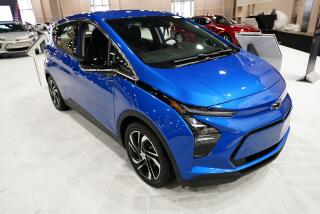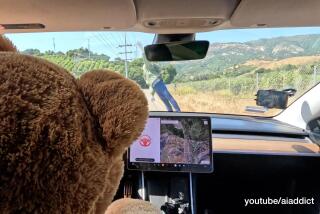Driving Out the Defects
DEATH VALLEY NATIONAL PARK, Calif. — It wasn’t quite 11 a.m., but the thermometer at Stovepipe Wells already read 117 degrees.
Bob Ditner smiled. The late-summer heat was just what the Toyota Motor Corp. engineer needed to test the new front brakes on a 2006 Lexus sedan.
For two hours he ran the Lexus on a winding, two-lane road that quickly dropped from 5,000 feet on the western rim to sea level on the valley floor. He hit the brakes more than 100 times -- instruments recorded every detail -- as the brake pads soared to more than 800 degrees. At that temperature, brake fluid would boil if the system wasn’t properly insulated and air bubbles would form in the brake lines, making the brakes inoperable. Under those circumstances, when a driver hits the brake pedal, it “will go right to the floor and you’ll keep on going,” Ditner said.
Driving at 60 mph at the bottom of the slope, he slammed on the brakes. The Lexus stopped straight, true and quickly. Hot brakes may “seem like a little thing, but many drivers use their brakes constantly going downhill, and that’s what we want to protect against,” Ditner said.
Despite the use of increasingly realistic computer simulations, his crew was in Death Valley doing what automakers still have to do to new cars: give them road tests under the toughest conditions imaginable. In the auto trade they call it extreme testing.
Each year automakers introduce about a dozen all-new passenger vehicles, while a hundred or so other models are delivered with major changes to transmissions, air conditioning, lights, suspensions, even door seals. The typical car or truck has about 3,000 parts, and automakers test new pieces individually, often with computer simulations or in laboratories. But ultimately these pieces must be bolted onto a car and put on the road to find out how they all work -- or don’t -- by exposing them to extreme bumps, bangs, heat, cold, dirt and damp.
It’s a crucial step to keep product quality high because reliability surveys by J.D. Power & Associates, Consumer Reports and others can heavily influence car sales.
“We have a motto, ‘Genchi gimbutsu,’ that translates as ‘Go and see,’ ” said Chuck Gulash, director of testing at Toyota’s U.S. technical center in Ann Arbor, Mich. “We go and see for ourselves how something will function in adverse conditions.”
Toyota has more than 1,000 engineers and technicians focusing on extreme testing, and Ford Motor Co. has about 1,500 test engineers. Other automakers have similar staffs. Their extreme road tests have pinpointed air filters that let dust into passenger cabins, brake parts that overheat and crumble, and wiring harnesses that fray and crack in extreme cold.
To run these tests, carmakers set up hot-weather test tracks in Arizona and cold-weather facilities in Northern Canada. They also road-test cars on grueling climbs up Colorado’s Pike’s Peak, in Arizona’s choking red dust and in Mexico City’s helter-skelter traffic. Overseas, winter road tests are done in Scandinavia and the Alps and summer spins are in Spain or in the Algerian and Australian deserts.
Death Valley is a favored summer test spot because its broiling sun bakes plastic parts, toasts paint and stresses radiators and air conditioners.
“Everyone uses it,” said Ditner, who pointed out rival test crews from Nissan, Mercedes-Benz and Aston Martin during his Lexus braking run.
Riding with Ditner was a senior Toyota brake systems engineer from Japan, while two other engineers drove behind in a rented Ford minivan, watching the Lexus for signs of distress such as smoke from burning brakes pouring from the front wheels.
Ditner’s team found no obvious flaws in the Lexus brakes. But it also was gathering information on how long it took to slow from 55 mph to 35 mph downhill, plus other data to track how well the computer-controlled brakes melded with Lexus’ new integrated traction and skid control system.
It was the second day of a four-day road trip that concluded with what Ditner called a brutal climb up Pike’s Peak.
Toyota requires that prototypes of new cars be driven for 100,000 miles. For the U.S. market, that is usually done on the company’s 10-mile test track outside of Phoenix. Alternating shifts of drivers run the vehicles 20 hours a day, five days a week, for as long as 10 months.
Each car company sets its own standards for durability tests.
Swedish automaker Volvo, now owned by Ford, was busy as it prepared to introduce a turbocharger on a 1998 model. Volvo engineers around the globe clocked nearly 2 million miles of on-road and track testing before the car hit the market, said Anders Berndtsson, technical team manager at the Volvo Arizona Proving Grounds.
These days automakers have compiled so much data on so many components that most new parts or systems can be tested accurately with a computer or automated simulation.
Ford has an indoor facility in Michigan that duplicates many climate, elevation and road conditions. Inside, monsoons are fed from overhead rainmaking nozzles and giant blowers create winds that drive blizzards made in snow machines. The test building can be pressurized to simulate varying elevations. And automotive treadmills can create speed and road surface conditions to mimic situations such as a smooth German autobahn or a rock-strewn off-road path in Utah.
With all this technology, it’s rare that a major part gets installed in a car or truck with a hidden, serious flaw. Still, mistakes happen.
When a redesigned 2005 Toyota Avalon sedan was tested a year before its introduction, a new, flat windshield wiper design was found to have a major flaw. Engineers at Toyota’s cold-weather center in Timmins, Canada, discovered that snow collected on the back of the aerodynamic blade until it was so heavy that the wiper stopped moving.
“We were proud of that design. It was really clean and smooth, but we had to send it back,” Gulash said. The Avalon delivered to dealerships early this year came with a revised wiper blade bent at a steeper angle to shed snow.
Testing goes on even after cars are introduced into the market.
Last fall Volvo sent 30 of its 2005 model year station wagons to Baja California to see how its new all-wheel-drive system would hold up under extreme pounding on routes used by off-road racers.
Driving over rutted dirt tracks strewn with rocks, testers put about 2,000 rough miles on each vehicle that survived the trip. Several of the Volvo wagons broke down with damaged oil pans and shock absorbers when drivers sped too energetically into ruts and rocks. One Volvo left an oil trail in the rock path and had to be towed for about 350 miles out of the southern Baja interior.
After the tests, all of the cars were shipped back to Volvo’s Arizona facility, where engineers tore them apart.
“They were badly beaten up, but we didn’t find any failures” in computer controls, sensors and hydraulic valves that make the electronic speed-sensitive, self-adjusting suspension work, said Christian Thalen, general manager of Volvo’s proving grounds near Phoenix.
Extreme road tests are tough on vehicles, but cold-weather testing also can strain engineers working in these remote winter locations.
At Toyota’s Timmins test site, 650 miles north of Detroit, snowfall averages close to 150 inches a year and winter temperatures can fall to 50 degrees below zero.
Jose Gonzalez, a Toyota electrical systems specialist, has spent six seasons -- from mid-November to late February -- in Timmins.
When the test site closes, Gonzalez said, the dozen staffers are “pretty happy” to return to Toyota facilities in Southern California, Michigan or Japan. Some engineers who worked one season in Timmins asked never to be reassigned there. “It can get lonely,” he said.
But the cold-weather tests in Canada helped Toyota discover several design flaws. In the mid-1970s, engineers in Timmins discovered that Toyota’s ventilating systems couldn’t get rid of humidity that built up during the day as drivers repeatedly tracked snow onto the floor mats.
“The windows would fog up, so we had to design more powerful ventilation to keep the glass clear,” Gulash said.
The cold-weather lab also led to a redesign of a trunk lock for a mid-1990s Toyota model after engineers found that moisture from melted snow couldn’t drain from the lock cylinder and it froze overnight.
On the last day of the winter season this year, Gonzalez’s job was to conduct a 10 a.m. cold-start battery test on a 2005 Toyota Camry. It was fairly warm for February -- about 10 below zero.
“We want to make sure the batteries and engine fluids will stand up to this cold, so we leave the car out overnight,” he explained, buttoning himself into a thick parka and pulling on heavy gloves before venturing outside.
Instruments were set up to record the amount of juice generated by the battery, and the data will help Toyota design engine oils, radiator fluids and batteries that work consistently in subzero temperatures.
Gonzalez’s assistant turned the key and the Camry started right up. Gonzalez nodded in appreciation and got ready to head south.






